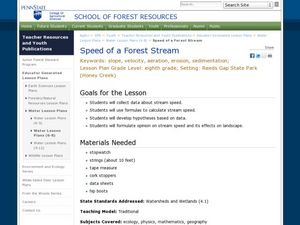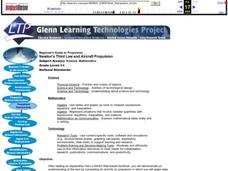Curated OER
Cannonball
Learners calculate the speed, motion and distance of a projectile. In this geometry lesson, students obtain measurements while calculating velocity. They graph their results and make predictions.
Curated OER
Check It Out
Students discuss the many processes involved with personal banking. They create their own budget based on their career choices. They also practice balancing a checkbook.
Curated OER
Water Regulation
High schoolers use their basic knowledge of physiology to analyze graphical data of paramecia under diverse conditions. From the data analysis, Students develop explanations of the animal's response to the concentration of different...
Curated OER
Diameter, Radius and Area
Students calculate the diameter, radius and area of a circle. For this geometry lesson, students investigate the different ratios of a circle. They calculate the surface are of each circle.
Curated OER
Triangles & Congruence, Proportions & Similarity, Right Triangle & Trigonometry
Young scholars are introduced to the topic of congruence and proportions in Geometry. Using technology, they construct and validate the properties of various geometric figures and identify whether it is congruent or proportion to the...
Curated OER
World Population Study
Students explore an exponential relationship and how it relates to human population growth and the current global population crisis. They graph both exponential and linear information.
Curated OER
WORLD POPULATION STUDY
Students explore an exponential relationship and how it relates to human population growth and the current global population crisis.
Curated OER
Tessellation
Pupils create an art piece incorporating tessellating shapes, translational symmetry, reflectional symmetry,and or rotational symmetry. They are asked if they know the definition of tessellation. If so, students are asked what shapes...
Curated OER
Speed of a Forest Stream
Students study stream speed. For this stream speed lesson students complete an activity and formulate an opinion and study its effects.
Curated OER
Don't Let Parabolas Throw You
Students identify relation, function, patterns and range. In this algebra lesson, students factor and graph quadratic equations. They use transformation to move the parabola around and make predictions.
Curated OER
Symmetry: Theory, Reality and Art!
Students explore the concept of geometric symmetry. For this geometric symmetry lesson, students walk around their school and take pictures of objects that demonstrate symmetry. Students use Microsoft Paint to draw the lines of symmetry...
Curated OER
Newton's Third Law and Aircraft Propulsion
Students research propulsion, graph data, and interpret the results.
Curated OER
The Lift Equation Problem Set
Students, after reading the Lift Equation page from a NASA Web-based textbook, demonstrate an understanding of the lift equation by answering questions.
Curated OER
Altitude and Flight Forces
Learners use the World Wide Web to access and use FoilSim. They also use the World Wide Web to access the NASA Glenn Web site for information relative to the factors involved with the flight of an airplane.
Curated OER
Exploring the Celestial Neighborhood
Ninth graders study the origin and organization of the solar system. They investigate the Earth's place in the system and how planetary motions explain natural phenomena observable from Earth.
Curated OER
Here's Looking at You
Students assess some common inherited traits which are easily observable and note their phenotype for the trait. Students compare their phenotypes to those of their parents and attempt to describe the pattern and manor of inheritance.

















